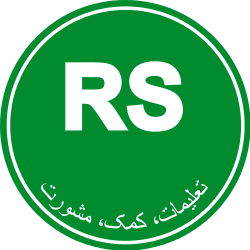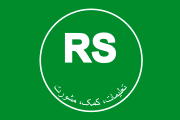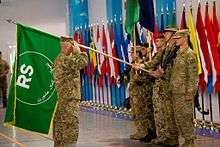Resolute Support Mission
| Resolute Support Mission | |
|---|---|
 Official logo of RSM | |
| Founded | December 28, 2014 |
| Country | Contributing States: See Below |
| Allegiance |
|
| Size | 16,229 troops as of September 2018[1] |
| Part of |
Allied Joint Force Command Brunssum American contingent responsible to:United States Central Command MacDill AFB, Florida, U.S. |
| Headquarters | Kabul, Afghanistan |
| Engagements | War in Afghanistan |
| Commanders | |
| Commander | GEN Austin S. Miller, USA |
| Deputy Commander | Lt Gen Richard Cripwell, GBR |
| Senior Enlisted Leader | CSM David Clark, USA |
| Insignia | |
| Flag |
 |

Resolute Support Mission or Operation Resolute Support is a NATO-led train, advise and assist mission consisting of over 13,000 troops in the Islamic Republic of Afghanistan, which began on January 1, 2015.[2][3] It is a follow-on mission to the International Security Assistance Force (ISAF) which was completed on December 28, 2014.[3][4] Its current commander is U.S. Army General Austin S. Miller who replaced U.S. Army General John W. Nicholson Jr. on 2 September 2018.[5]
Legal basis
The operation plan for the Resolute Support Mission (RSM) was approved by foreign ministers of the NATO members in late June 2014 and the corresponding status of forces agreement was signed by President of Afghanistan Ashraf Ghani and NATO Senior Civilian Representative in Afghanistan Maurits Jochems in Kabul on 30 September 2014.[3] The United Nations Security Council unanimously adopted United Nations Security Council Resolution 2189 in support of the new international mission in Afghanistan.[4]
Objectives and deployment
The objective of the mission is to provide training, advice and assistance for Afghan security forces and institutions in their conflict with extremist groups such as the Taliban, the Haqqani network, and ISIS-K.[6][7]
The Resolute Support Mission envisages the deployment of approximately 12,000 personnel from NATO and partner nations in Afghanistan with the central hub at Kabul and Bagram Airfield supporting four spokes.[3] The spokes will be formed by Train Advise Assist Commands (TAACs), which will directly support four of the six Afghan National Army Corps. Train Advise Assist Command - Capital replaces the former Regional Command Capital; the redesignation took place in August 2014. TAAC East will assist the 201st Corps from FOB Gamberi and FOB Fenty located near Jalalabad, TAAC South will assist the 205th Corps from Kandahar International Airport, TAAC West will assist the 207th Corps in Herat and TAAC North will cover the 209th Corps from Mazar-i-Sharif. TAAC North is under the command of Brig. Gen. Harald Gante, German Army.[8] Regional Command North was redesignated as TAAC North on July 1, 2014.[9]
The 203rd Corps located in the south-eastern part of the country will see advisers from time to time from TAAC East (one source describes this as "fly to advise").[10] The 215th Corps in the south-west will get a little attention from TAAC South. Several of the TAACs were established prior to the disestablishment of ISAF; they can be seen on the December 2014 ISAF status update sheet.[11]
U.S. President Barack Obama, in an update given from the White House on Wednesday, July 6, 2016, stated that, following General John W. Nicholson's, Joint Chiefs of Staff Chairman General Joseph Dunford's, and U.S. Defense Department Secretary Ashton Carter's mutual recommendations, the U.S. would have about 8,400 troops remaining in Afghanistan through the end of his Administration in December 2016.[6]
The residual force of 9,800 troops were withdrawn on December 31, 2016, leaving behind 8,400 troops stationed at four garrisons (Kabul, Kandahar, Bagram, and Jalalabad).
Contributing nations
As of June 2016, among the forces contributing to the mission are 6,954 Americans training and helping Afghan forces, 2,850 Americans engaged in counter-terrorism missions, 5,859 NATO soldiers and 26,000 military contractors.[12]
A new U.S. unit, the 1st Security Force Assistance Brigade, deployed to Afghanistan in February 2018.[13]
The United Kingdom announced in July 2018 that it was to send 440 more British personnel to Afghanistan. Around half of the additional personnel will deploy to the country in August 2018 and the other half to follow by February 2019. This will increase the total number of British personnel in the country from 650 to 1,090 by early 2019. [14]
The following nations have personnel stationed in Afghanistan as part of the mission in September 2018:[1]
| Country | Number of Troops |
|---|---|
| 8,475 | |
| 1,300 | |
| 895 | |
| 870 | |
| 693 | |
| 650 | |
| 506 | |
| 315 | |
| 300 | |
| 281 | |
| 193 | |
| 160 | |
| 158 | |
| 155 | |
| 136 | |
| 121 | |
| 120 | |
| 120 | |
| 105 | |
| 93 | |
| 78 | |
| 63 | |
| 55 | |
| 50 | |
| 47 | |
| 40 | |
| 40 | |
| 37 | |
| 36 | |
| 29 | |
| 29 | |
| 20 | |
| 17 | |
| 13 | |
| 11 | |
| 8 | |
| 6 | |
| 2 | |
| 2 | |
| Total | 16,229 |
Quotes from Congressional reports
The Special Inspector General for Afghanistan Reconstruction (SIGAR) is Congressionally appointed to oversee the $117.26 billion that Congress has provided to implement reconstruction programs in Afghanistan. The SIGAR's "April 30, 2018 Quarterly Report to Congress" says, "[As of January 31, 2018,] 14.5% of the country’s total districts [were] under insurgent control or influence [& an additional 29.2% were] contested[.]"[15]
"Stabilization: Lessons from the U.S. Experience in Afghanistan" is the fourth lessons learned report issued by the SIGAR.[16] It says:
[...] LESSONS [...] 5. Physical security is the bedrock of stabilization. [...] 10. Winning hearts and minds requires a close examination of what has won and lost the hearts and minds of that particular population in the recent past. [...] RECOMMENDATIONS [...] EXECUTIVE BRANCH [...] 2. DOD and USAID should update COIN and stabilization doctrine and best practices to stagger stabilization’s various phases, with the provision of reliable and continuous physical security serving as the critical foundation. [...]
"Reconstructing the Afghan National Defense and Security Forces: Lessons From the U.S. Experience in Afghanistan" is the second in a series of lessons learned reports issued by the SIGAR.[17] It says:
[...] KEY FINDINGS [...] 10. ANDSF monitoring and evaluation tools relied heavily on tangible outputs, such as staffing, equipping, and training levels, as well as subjective evaluations of leadership. This focus masked intangible factors, such as corruption and will to fight, which deeply affected security outcomes and failed to adequately factor in classified U.S. intelligence assessments. [...] LESSONS [...] Lesson 5. Security force assessment methodologies are often unable to evaluate the impact of intangible factors such as leadership, corruption, malign influence, and dependency, which can lead to an underappreciation of how such factors can undermine readiness and battlefield performance. [...] RECOMMENDATIONS [...] DOD-SPECIFIC RECOMMENDATIONS 1. Prior to the initiation of an SSA mission—and periodically throughout the mission—DOD should report to the U.S. Congress on its assessments of U.S. and host-nation shared SSA objectives, alongside an evaluation of the host nation’s political, social, economic, diplomatic, and historical context, to shape security sector requirements. [Lesson 2] [...] 2. DOD should lead the creation of new interagency doctrine for security sector assistance that includes best practices from Afghanistan, Iraq, Bosnia, Kosovo, and Vietnam. [Lesson 1] [...] AFGHANISTAN-SPECIFIC RECOMMENDATIONS [...] DOD-Specific Recommendations [...] 2. Conduct a human capital assessment of the ANDSF conventional and special forces. [Lessons 2, 4, 5, 9] [...] 3. Review combat and logistics enabler support to the ANA. [Lessons 1, 2, 5] DOD should review combat and logistics enabler support to the ANA and draft a transition plan for aviation requirements. In part, the U.S. military’s train, advise, and assist efforts since 2002 resulted in conventional ANA units dependent on close air support, medical evacuation, route clearing, protected mobility, accurate fires overmatch, and ISR capabilities. This lack of combat enablers and resulting equipment losses and high casualty rates has resulted in fewer offensive operations for larger conventional forces who are more prone to stay on base in the absence of combat enablers. Afghan combat enablers were not part of initial design decisions and are still largely underdeveloped, compared to the operational requirements. [...] 5. Expand the train, advise, and assist mission below the corps level. [Lessons 1, 2] [...] In 2012, Chairman of the Joint Chiefs of Staff Martin Dempsey testified, “[...] The bond between our forces and the Afghan forces will ultimately be what gets [the Taliban] defeated.” [...]
"Afghanistan: Post-Taliban Governance, Security, and U.S. Policy", December 13, 2017, is a report by Kenneth Katzman & Clayton Thomas of the Congressional Research Service.[18] It says:
Summary The United States, partner countries, and the Afghan government are attempting to reverse recent gains made by the resilient Taliban-led insurgency since the December 2014 transition to a smaller international mission consisting primarily of training and advising the Afghanistan National Defense and Security Forces (ANDSF). [...] [The ANA] special operations component, trained by U.S. Special Operations Forces, numbers nearly 21,000, and U.S. commanders say it might be one of the most proficient special forces in the region.92 Afghan special forces are utilized extensively to reverse Taliban gains, and their efforts reportedly make up 70 to 80 percent of the fighting.93 The problem of absenteeism within the ANA is in large part because soldiers do not serve in their provinces of residence. Many in the ANA take long trips to their home towns to remit funds to their families. However, absenteeism has eased somewhat in recent years because almost all of the ANA is now paid electronically. [...]
Enhancing Security and Stability in Afghanistan-June 2016 is a report issued by the DoD as required under the National Defense Authorization Act (NDAA).[19] It says:
[...] U.S. OBJECTIVES IN AFGHANISTAN With support from the Afghan government and the Afghan people, USFOR-A is conducting two well-defined and complementary missions as part of OFS to achieve U.S. objectives and build upon the gains of the last 14 years.6 First, through OFS, U.S. forces are continuing the counterterrorism mission against al Qaeda and its associates in Afghanistan to prevent its resurgence and external plotting against the homeland and U.S. targets and interests in the region. Second, in coordination with NATO Allies and operational partner nations, U.S. forces are conducting a TAA mission to continue building the capabilities and long-term sustainability of the ANDSF, the MoD, and the MoI. [...] STRATEGY The Afghans have made modest progress in moving towards a more offensive-oriented and sustainable strategy, but they continue to struggle with proactively pursuing the Taliban and holding areas once cleared. Coalition advisors have been working with ANDSF leaders on implementing a more sustainable security strategy that capitalizes on force consolidation to generate offensive combat and policing power and maneuverability and that ensures the ANDSF are postured to provide security to key areas of the country. In addition, ANDSF, MoD, and MoI leadership are now beginning to drive long-term transformations across the force as evidenced by their ongoing development and refinement of a five-year National Military Strategy (NMS)[.] [...] Areas of improvement for the ANDSF include maneuver capability, maintaining operational readiness, cross-pillar coordination and cooperation, and the need to increase offensive, intelligence-driven operations to seize and retain the initiative from the insurgency. [...] ANA units are still reluctant to conduct offensive operations without ASSF support because of the combat-enabling support – in particular aerial fires – which the coalition provides to the ASSF. [...] At the operational level, the MoD, in concert with coalition advisory efforts, identified several priority issues including the improvement of force allocation and consolidation to generate more combat power in support of a more offensive strategy. [...] The AAF is forecast to reach full operational capability in aerial fires mission sets by early 2019. [...]
References
- 1 2 "Resolute Support Mission: Key Facts and Figures" (PDF). NATO. September 2018.
- ↑ "NATO chief, Afghan president welcome "new phase" as combat role ends". DPA. DPA. 2 December 2014. Archived from the original on 7 February 2015. Retrieved 7 February 2015.
- 1 2 3 4 "NATO-led Resolute Support Mission in Afghanistan". NATO. 27 November 2014. Retrieved 16 December 2014.
- 1 2 "Afghanistan: Security Council backs agreement on new non-combat NATO mission". United Nations News Centre. 12 December 2014. Retrieved 16 December 2014.
- ↑ "Change of Command at NATO-led Resolute Support Mission in Afghanistan" (Press release). NATO. 2 September 2018. Retrieved 2 September 2018.
- 1 2 "An Update On Our Mission in Afghanistan". whitehouse.gov. 6 July 2016. Retrieved 18 July 2016.
- ↑ Rosenberg, Matthew (October 15, 2015). "In Reversal, Obama Says U.S. Soldiers Will Stay in Afghanistan to 2017". The New York Times. Retrieved 1 September 2017.
- ↑ Operation Resolute Support, TAAC North Archived 2015-01-01 at the Wayback Machine.
- ↑ Bundeswehr, Train Advise Assist Command North – Baustein für die Zukunft Afghanistans Mazar-e Sharif, 17.07.2014., accessed 1 January 2015.
- ↑ "Resolute Support". Afghan War News. Afghan War News. Retrieved 7 February 2015.
- ↑ "International Security Assistance Force (ISAF): Key Facts and Figures" (PDF). NATO. NATO. Retrieved 7 February 2015.
- ↑ "War in Afghanistan". The Economist. 11 June 2016. Retrieved 11 June 2016.
- ↑ "First troops among new front-line adviser brigade arrive in Afghanistan". Stars and Stripes. Retrieved 2018-09-06.
- ↑ "Afghanistan: UK to send 440 more non-combat troops".
- ↑ "April 30, 2018 Quarterly Report to Congress" (PDF).
- ↑ "Stabilization: Lessons from the U.S. Experience in Afghanistan" (PDF).
- ↑ "Reconstructing the Afghan National Defense and Security Forces: Lessons From the U.S. Experience in Afghanistan" (PDF).
- ↑ "Afghanistan: Post-Taliban Governance, Security, and U.S. Policy" (PDF). Archived from the original (PDF) on 2005-05-07.
- ↑ "Enhancing Security and Stability in Afghanistan-June 2016" (PDF).